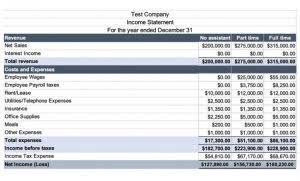
This page briefly explains the meanings of and the difference between cumulative and noncumulative preferred stock. After common stock, preferred stock is the second popular class of equity instruments that corporations sell to manage funds for their operations. The preferred stock issued by a corporation generally belong to one of the two main types – cumulative or noncumulative. Non-cumulative preferred stock can be a valuable addition to an investor’s portfolio, but it’s important to conduct thorough research and understand the potential risks and rewards before investing. Investors should carefully consider the features, advantages, and risks of non-cumulative preferred stock when making investment decisions.
Consider the SPDR® ICE Preferred Securities ETF
These dividend payments are guaranteed but not always paid out when they are due. Unpaid dividends are assigned the moniker “dividends in arrears” and must legally go to the current owner of the stock at the time of payment. At times additional compensation (interest) is awarded to the holder of this type of preferred stock. Most preference shares have a fixed dividend, while common stocks generally do not. Preferred stock shareholders also typically do not hold any voting rights, but common shareholders usually do.

Create a Free Account and Ask Any Financial Question
The priority in asset distribution, especially during liquidation, enhances its appeal, appealing to risk-conscious investors. While this provides flexibility to the company, it introduces an element of uncertainty for investors, as their investment could be redeemed earlier than expected. Convertible preferred stock adds another layer of flexibility to the investment.
- Thus companies should maintain a balanced capital structure having a proper mix of Equity, Cumulative, and Non Cumulative Preference shares.
- Participating preferred stock comes with the potential for additional dividends beyond the fixed rate.
- If the company’s profits exceed a certain threshold, participating preferred shareholders are entitled to receive extra dividends.
- Because of their characteristics, they straddle the line between stocks and bonds.
- It does not take into account any investor’s particular investment objectives, strategies, tax status or investment horizon.
View All Financial Services & Investing
This preference ensures a certain level of stability in dividend payouts, making preferred stock an appealing option for income-oriented investors. If the issuing company chooses not to pay a dividend for a specific period, the right to receive that dividend expires, and investors will not receive the missed dividend in the future. Cumulative and non-cumulative stocks are two types of stock options available to shareholders. While the former makes it mandatory for firms to pay off the dividends when noncumulative preferred stock accumulated, the latter keeps the firms off from the obligation of mandatory payment of dividends to shareholders. SSGA Intermediary Business offers a number of products and services designed specifically for various categories of investors.

Preferred stock have specific features different from common stock, so they may perform differently. However, both Bookkeeping for Chiropractors investments are reflections of the performance of the underlying company. Should the company begin to struggle, this may result in a loss or decrease in value in the preferred stock price. Preferred stock issuers tend to group near the upper and lower limits of the creditworthiness spectrum.
- ETFs trade like stocks, are subject to investment risk, fluctuate in market value and may trade at prices above or below the ETFs net asset value.
- Individual and institutional investors can both benefit from the steady income that they can be paid.
- Changes in market sentiment, company performance, or broader economic conditions can impact the market value of preferred stock.
- Preferred stocks often have no maturity date, but they can be redeemed or called by their issuer after a certain date.
- As investors evaluate whether preferred stock aligns with their financial goals and risk tolerance, several key considerations come into play.
With preferreds, the investor is standing closer to the front of the line for payment than common shareholders, although not by much. Investors are more willing to purchase cumulative preferred stock, since they have a greater likelihood of being paid dividends. Non-cumulative preferred stock does not accumulate unpaid dividends, whereas cumulative preferred stock does. The potential loss of missed dividends, limited protection for investors, and lower priority in liquidation are the main disadvantages of non-cumulative preferred stock.

About AtheneAthene is a leading retirement services company with over $350 billion of total assets as of September 30, 2024, and operations in the United States, Bermuda, Canada, and Japan. Athene is focused on providing financial security to individuals by offering an attractive suite of QuickBooks retirement income and savings products and also serves as a solutions provider to corporations. Preferred shares usually do not carry voting rights, although under some agreements, these rights may revert to shareholders who have not received their dividend. Preferred stock is often compared to bonds because both may offer recurring cash distributions. However, as there are many differences between stocks and bonds, there are differences with preferred equity as well.

The highest ranking is called prior, followed by first preference, second preference, etc. Second, preferred stock typically do not share in the price appreciation (or depreciation) to the same degree as common stock. The inherent value of preferred stock is the ongoing cash proceeds that investors receive. However, because they are not tied to semi-fixed payments, investors hold common stock for the potential capital appreciation. In most cases, convertible preferred stock allows a shareholder to trade their preferred stock for common stock shares.
- Please reach out to your financial professional if you have any questions about insurance products and their features.
- For example, if ABC Company fails to pay the $1.10 annual dividend to its cumulative preferred stockholders, those investors have the right to collect that income at some future date.
- Passively managed funds invest by sampling the index, holding a range of securities that, in the aggregate, approximates the full Index in terms of key risk factors and other characteristics.
- If management does not declare a dividend in a particular year, there is no question of ‘dividends in arrears’ in case of noncumulative preferred shares.
- This lack of voting rights can be viewed as a trade-off for the dividend priority and stability that preferred stock offers.

All of our content is based on objective analysis, and the opinions are our own. The repercussions of legal modifications can considerably affect the worth and utilization of noncumulative instruments. Not all reinsurance products or structures offered are available in all jurisdictions. All transactions are subject to meeting a reinsurer’s underwriting requirements. Reinsurance products are not protected or guaranteed by state insurance guaranty associations or insolvency funds. My Accounting Course is a world-class educational resource developed by experts to simplify accounting, finance, & investment analysis topics, so students and professionals can learn and propel their careers.
